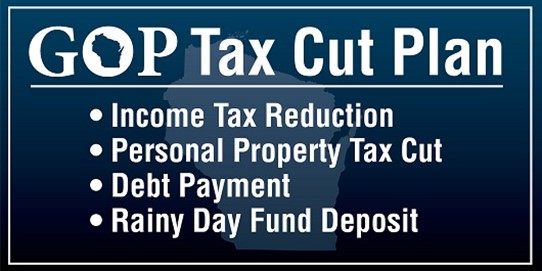

In a recent newsletter, I shared with you the excellent news that, because our state's economy is continuing to outperform expectations, we're forecasting a budget surplus. A big surplus. Two big surpluses. Specifically: despite enacting a middle-class income tax cut in summer 2019, and despite record-high new funding for K-12 public schools, and despite historic new investments in health care, your state government still expects to collect about $400 million more in tax revenues than we budgeted in FY 2020 and another $400 million extra in FY 2021.
The way I see it, that's your money. We've overcharged you and we're going to give it back. Earlier today, Republicans announced how exactly we plan to do that. We propose:
- Increasing the standard deduction on your state income taxes beginning in Tax Year 2020. This has the effect of targeting the tax cut to low- and middle-income families by an average of about $105 per year without making taxes any more complicated than they already are. As I mentioned, it would be the second major income tax cut in less than 12 months.
- Phasing out another piece of the Personal Property Tax. Businesses (that is, job creators) spend a fortune every year accounting for and filing this complicated tax on the value of their equipment; for small businesses in particular, it sometimes costs more to compute the tax than to pay the tax! I look forward to fully repealing this inefficient tax someday; in the meantime, we propose taking a big step in that direction.
- Making a special debt-reduction payment. Basically, when the state government constructs a new building (say, a new classroom building at the University of Wisconsin), the government arranges to make payments over a period of years. It's not unlike arranging to purchase your house by taking out a home mortgage loan over a period of years. Our budget surplus provides an opportunity to reduce the cost to you of the borrowing that has already been undertaken in recent years.
- Making a new deposit into the state's "Rainy Day Fund," which helps ensure that a future economic downturn would not trigger tax hikes that could compound a future crisis. Several years ago, the state had practically zero money in this fund; today, the balance is over $600 million, and under our plan, the balance would approach $1 billion.
This plan builds on the tax cuts that have already returned at least $13 billion to your pockets over the past 10 years, and it makes smart choices that protect you in the future, too. And it's the right thing to do: we don't need to grow government or increase spending when we already have a bipartisan budget in place that funds our priorities at historic levels.
As always, I encourage you to follow my updates on social media or contact my office directly with your questions. Best wishes on your weekend!

Fun Facts for Valentine's Day
Tax policy is heavy stuff; I think I'll end the week on a lighter note! Try out these facts on your loved ones:
- Every year in February, thousands of people write letters to Juliet (of Shakespearean fame) addressed to Verona, Italy. And a group of volunteers from the Juliet Club write replies! The club also awards a prize every year to the author of the most romantic love letter.
- The ancient Romans celebrated a festival called Lupercalia. As part of this pagan celebration, boys would run through crowds of people with strings made from goatskins; if a girl was touched by a string, she was supposed to be purified and have healthy children when she grew up. The goatskins were called februa, a Latin word meaning "purify" and, some say, the origin of the name of the month of February.
- During the 1800s, it was very popular in the U.S. and Great Britain to exchange Valentine's Day cards by mail. It was also popular to anonymously send "vinegar valentines," which could be mocking or even cruel, to people you didn't like. Things got so bad for a while that the London postal carriers would sometimes confiscate vinegar valentines instead of delivering them. Ouch!
- According to no less a source than the Washington Post, in the Middle Ages, the letter "X" came to represent Christianity and the cross; people would add this sign at the bottom of letters or documents, and they would kiss the X as a sign of their oath. As the gesture became more commonplace, this came to be known as "sealing it with a kiss." And, ever since, X has been a symbol of a kiss!
Office of Representative Terry Katsma
State Capitol, Room 306 East
P.O. Box 8952
Madison, WI 53708
(608) 266-0656
Rep.Katsma@legis.wisconsin.gov| |
|
|
|
|